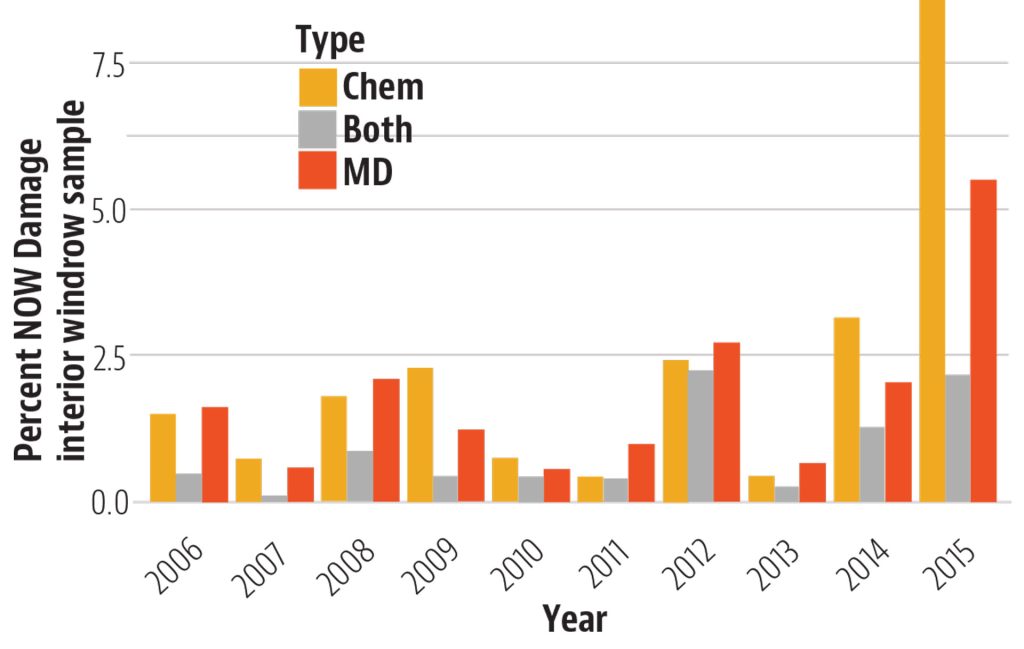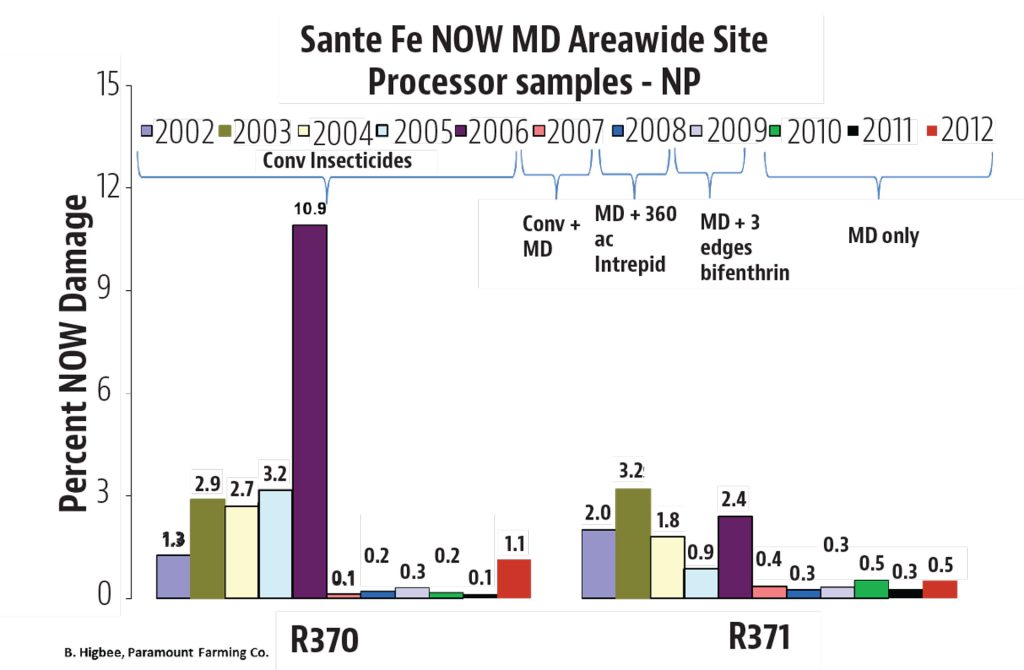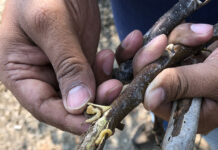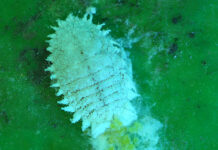The navel orangeworm (NOW) continues to be public enemy #1 for most almond growers in California. Current efforts using the sterile insect technique and future efforts with new technologies could benefit from an areawide approach. In simple terms, this strategy coordinates control efforts over relatively wide areas in which hosts of a given pest are grown. These programs have proven successful in a number of crop systems, including pink bollworm in cotton, codling moth in apples and screw worm in cattle.
Shortly after I arrived in Bakersfield, Calif. in 2002 to start an entomology research program for Paramount Farming (which later became Wonderful Orchards), it was apparent that NOW could benefit from such a program because of the importance of sanitation, the need for good spray timing and the recent demonstration of mating disruption as an effective management tool. Having directed two such areawide projects in apples and pears for codling moth management during my tenure with USDA-ARS in Yakima, Wash., I approached the National Program staff of USDA-ARS to explore the possibility of funding such a program for NOW. The funding was ultimately approved in 2007, and Joel Siegel of the Parlier Station was chosen to administer the NOW Areawide Project, which began in 2008 and continued to 2012. For the purpose of this project, the definition of areawide was expanded to a statewide focus on nut crops. Researchers from UC, USDA-ARS and the private sector were enlisted to perform research seeking new knowledge and solutions to several questions. Meanwhile, Wonderful Orchards (WO) had taken the initiative to start two separate 2,500-acre NOW Areawide projects (Lost Hills in 2006 and Santa Fe in 2007) to complement the individual research projects funded by the USDA.
The USDA funding for the NOW Areawide Project amounted to $3.5 million over five years and funded a myriad of projects. Research on NOW flourished during this period (2008-12), and included research directly funded through the Areawide project, co-funded with the Almond Board of California and independent work. In all, over 25 peer-reviewed scientific papers were published during this period, expanding our knowledge and improving our ability to manage NOW substantially. Among the topics were identification of the minor components of the NOW sex pheromone (allowing development of an attractive lure for monitoring), spray coverage improvement, discovery of a new kairomone attractant, multiple studies on aspects of NOW monitoring and relationships among trapping options, variable development rate of NOW on the same and different diets, spray timing and efficacy of insecticide programs, duration of control for commonly used NOW insecticides and relative efficacy of NOW insecticides.
In addition, WO self-funded two areawide projects (Lost Hills and Santa Fe) and related research projects investigating NOW, including insecticide program efficacy, spray coverage characterization and improvement, NOW monitoring and new lure development, predictive NOW damage modeling, bifenthrin resistance in NOW moths, mating disruption and NOW dynamics.
A list of publications and patents associated with the USDA-ARS NOW AW-IPM program can be found at github.com/ChuckBV/Y2008_to_2012_navel_orangeworm_areawide.
Results from the Areawide Sites
The combination of mating disruption (MD) and insecticides resulted in the lowest NOW damage (Higbee and Burks 2021).
One of the major outcomes of the Lost Hills Project (2006-15) was the demonstration that MD supplemented with two hull split sprays resulted in lower NOW damage than MD alone or the insecticide program alone (Fig. 1). All treatment areas received identical sanitation, nutrition and secondary pest inputs. The project site covered 2,500 contiguous acres and was planted in 1996 with Nonpareil, Monterrey, Sonora, Fritz, Carmel, Wood Colony and Price, with a relatively small area that included Ruby and Butte. Treatment areas were rotated each year of the study such that the insecticide-only treatment was situated on either the north or south end to minimize pheromone drift from NOW MD areas. The NOW insecticide program in all years consisted of two applications of methoxyfenozide (Intrepid), one spray directed at the first flight (typically in April) and one spray targeting the second flight (typically in late June/early July.) Aerosol dispensers were used as the pheromone source.

NOW MD and sanitation could stand alone with increased monitoring effort. (Rosenheim et al, JEE, 2017)
The idea that NOW MD along with sanitation could stand alone, with sufficient monitoring efforts that provided the confidence to make a “no-spray” decision, was validated in the Santa Fe Areawide Project (2007-12). The site chosen was a historical hot spot, largely due to very large trees that were difficult to sanitize adequately. This project was made up of two large ranch units; R370 was planted in 1990 with Nonpareil, Price, Butte and Sonora for a total of 950 ac and R371 was planted in 1993 with these same varieties plus Monterey, Carmel, Fritz, Price, less than 100 ac of Padre and Mission for a total of 1,700 acres. All treatment areas received identical sanitation and secondary pest inputs. These two ranch units were divided by a two-lane highway.
Figure 2 summarizes Nonpareil damage as measured from truckload samples delivered to the processor. This project was managed as a demonstration of what could be achieved with NOW MD combined with sanitation and increased monitoring over large areas. In the initial year of the project (2007), an aggressive insecticide program consisting of a spring application of Intrepid (April), a first hull split spray of Lorsban + Intrepid (late June) and a second hull split spray in late July consisting of bifenthrin (Brigade). This insecticide program was applied to both ranches, while in addition, R370 received NOW MD using aerosol dispensers. The resulting NOW damage in 2007 was much lower in both ranches relative to 2006, the addition of MD in R370 contributing to an even greater reduction than insecticides alone. NOW MD was used over the entire project in for the remainder of the project. The following two years, 2008 and 2009, the only insecticide applications for NOW applied (based on monitoring data) were to a hotspot of 360 acres in 2008 and borders in 2009. In the final three years of the project (2010-11), monitoring indicated no need for NOW insecticides, and damage remained at about 1% or less.

One MD aerosol dispenser per acre was effective at low to moderate NOW populations (Higbee and Burks 2021).
Another interesting study conducted in the Lost Hills Project from 2008-11 was the comparison of aerosol mating disruption at two different dispenser densities, with or without insecticide, was compared to insecticide treatment alone. There were five treatments: 1) insecticide treatment without mating disruption; 2) one mating disruption dispenser per acre without insecticide; 3) one mating disruption dispenser per acre with insecticide; 4) two mating disruption dispensers per ac without insecticide; and 5) two mating disruption dispensers per acre with insecticide. The two replicates of the no-mating disruption insecticide treatment were placed adjacent to each other and rotated each year at either the north or south end of the site to minimize the effect of the mating disruption treatments on the insecticide only treatment blocks.
Final Thoughts
These projects demonstrated that with sufficient monitoring, NOW could be managed optimally over time with the possibility of eliminating insecticide use directed at NOW. The results solidified the viability of NOW MD as a management tool and provided information on how to monitor and interpret collected data to make management decisions. Although precise damage thresholds were not developed, a predictive model incorporating various trap data and early split evaluations was developed that explained over 50% of the variation observed in NP damage. While it is difficult to make precise predictions, the best predictors are a combination of 1) adult female captures in almond-meal baited traps during the 3rd flight, and 2) infestation of the early split nuts.
Certainly, additional work has and will be done to optimize MD systems. These include passive MD dispenser systems, additional attractants for use as monitoring tools, precise dispensing of the sex pheromone, and the impact of the addition of minor sex pheromone components to MD formulations on disruption of communication between male and female moths. As more research addresses how to use MD most efficiently, it should ease and increase the adoption of this technology.




















